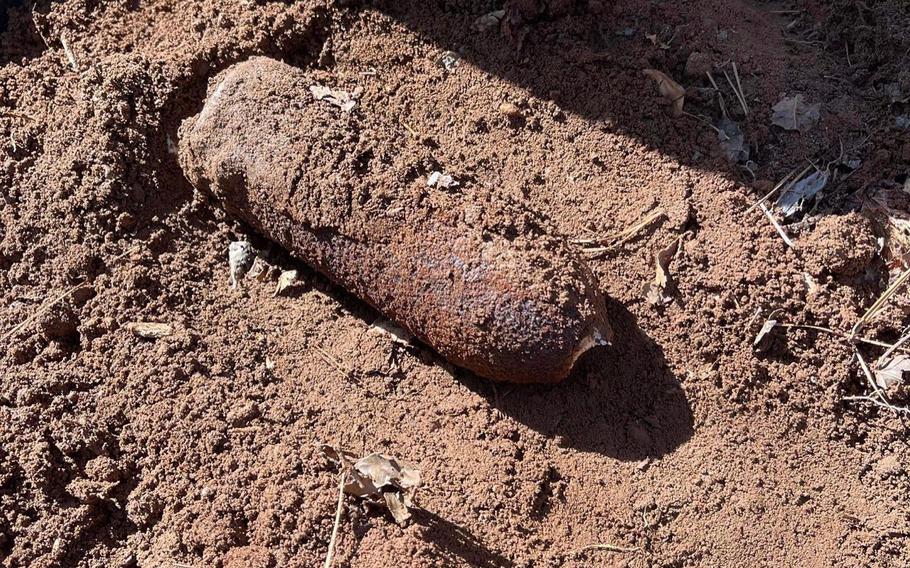
A Cobb County Police Department bomb squad was called to Kennesaw Mountain National Battlefield in Georgia, where a 157-year-old Union parrott shell from the Civil War was found. (Cobb County(Ga.) Police Departme)
Police in Cobb County, Ga., are planning to destroy a live Civil War artillery round found at Kennesaw Mountain National Battlefield Park last month. But do they really need to?
Civil War collectors and munitions experts are saying detonating the artifact to neutralize it will unnecessarily obliterate a piece of history. Live shells of this nature are easily defused and rendered safe by soaking them in water.
“Oh, you can get hurt by this thing - if you drop it on your foot,” remarked Jack Melton, publisher of the Artilleryman Magazine, a specialty publication about Civil War cannons and shells. “A propane tank in the back of your car would cause more damage.”
The live round was discovered by archaeologists at Kennesaw Mountain, the scene of a major Civil War battle in 1864. Located near Marietta, Ga., this hallowed ground is where Maj. Gen. William Tecumseh Sherman of the Union Army charged into Confederate forces headed by Gen. Joseph E. Johnston during Sherman’s famous March to the Sea. Kennesaw Mountain was a tactical defeat for the North but also a strategic loss for the South, which could not prevent Sherman from reaching Atlanta.
On Feb. 28, a survey crew was mapping a new hiking trail when it unearthed the live round in about 10 inches of dirt. Using metal detectors, the team found what was identified as a 10-pound Parrott shell - a kind of ordnance typically used by Union artillery during the Civil War.
According to a Facebook post by the Southeast Archaeological Center, the “intact” round had “a percussion fuse that did not ignite when it hit the ground.”
The bomb squad from the Cobb County Police Department was contacted. The squad removed the explosive to a bunker and planned to “counter charge the cannon shell” to make it harmless, according to a post on its Facebook page. That action would likely destroy the round, which is nearly 160 years old.
The reaction on social media - or on the small corner of it that concerns itself with Civil War-era munitions - was swift and fierce. “What a waste of a perfectly good historical artifact,” responded the Depths of History Facebook page, which is managed by a user called “Britain,” who claims to be a “treasure hunter, scuba diver, metal detectorist.” “Any historian would know that these items can be defused, preserved and put on display. It’s time to preserve history instead of destroying it.” Britain also shared a link to a YouTube video showing an identical shell being defused by an expert.
The Cobb police countered on Facebook that “the bomb squad stated that they would love nothing more than to preserve this piece of history, however there is no way to safely render it without counter charging it.”
Not so, said Melton, who also produces the Civil War News and Military Antique Collector for Historical Publications in Charleston, S.C. All the bomb squad needs to do, he said, is put the round in a bucket of water.
“These shells used paper fuses and black powder, which is not unstable,” he said in an interview. “Black powder becomes inert when it gets wet. Given that it was found 10 inches below the surface, it probably already is inactive. I’m sure it got wet from rainwater more than a few times in the past 157 years.”
Over the course of his lifetime, Melton said he has disarmed about 1,400 similar shells. The Civil War artillery enthusiast claimed it is a simple process of submerging the unexploded ordnance in water.
“Once it has been soaked, you can carry the shell around and nothing will happen,” he said. “When black powder gets wet, that’s it. You can take out the detonator and remove the main charge, which probably included case shot, a kind of antipersonnel round.”
According to the Marietta Daily Journal, the shell was probably fired by a Union battery commanded by Capt. Francis DeGress of the 1st Illinois Light Artillery. The unit included four Parrott cannons, a rifled artillery weapon invented by Capt. Robert Parker Parrott of the U.S. Army in 1860.
Unlike round cannonballs, Parrott projectiles are shaped more like modern artillery shells, with a long body and conical front piece. The shells featured explosive charges with paper fuses that burned at specific rates for different ranges. Because of the rifled barrels, Parrott cannons could fire shells farther and with greater accuracy that smoothbore cannons.
Melton hopes the bomb squad at the Cobb County Police Department will rethink its decision to blow up the historical artifact. He even is offering the services of a volunteer expert who is willing to defuse the live round at no charge.
“I have a friend who lives five minutes from Kennesaw Mountain,” he said. “He has done this a thousand times and said he would do it for free for the police. Like me, he wants to see this shell be displayed in a museum at the park.”
The Cobb County Police Department did not respond to several phone calls and emails.